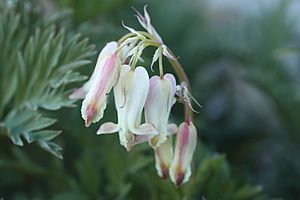Sierra bleeding heart facts for kids
Quick facts for kids Sierra bleeding heart |
|
|---|---|
 |
|
| Scientific classification | |
| Genus: |
Dicentra
|
| Species: |
nevadensis
|
The Sierra bleeding heart (scientific name: Dicentra nevadensis) is a special plant found only in certain parts of California. It's also known as the Tulare County bleeding heart. This plant is a perennial flowering plant, which means it lives for more than two years and blooms each year.
It grows only in rocky, gravelly areas high up in the Sierra Nevada mountains. You can find it in Tulare and Fresno Counties in California. This plant is "endemic" to these areas, meaning it naturally grows nowhere else in the world!
Scientists used to think it was just a type of another plant called the Pacific bleeding heart (Dicentra formosa). But now they know it's its own unique species. You can find the Sierra bleeding heart growing at very high elevations, from about 2,100 to 3,300 meters (that's about 6,900 to 10,800 feet) above sea level. Imagine how tough it must be to grow up there!
Contents
What It Looks Like
The Sierra bleeding heart has some interesting features that help you identify it.
Leaves and Stems
Its leaves are very finely divided, almost like delicate lace. They grow directly from the base of the plant, close to the ground. This helps the plant stay low and protected from strong winds in its mountain home.
Flowers
The flowers of the Sierra bleeding heart are truly unique and beautiful. They are shaped like tiny hearts, just like the name suggests! These heart-shaped flowers can be dull white, light pink, or even yellowish-brown. They hang down in clusters called racemes from bare stems that rise above the leaves. A raceme is like a stalk with many flowers attached along its sides. When these delicate flowers dry out, they turn black.
Seeds
After the flowers bloom, the plant produces seeds. These seeds are held inside a small case called a capsule. The capsule is usually about one to two centimeters long. These capsules protect the seeds until they are ready to spread and grow new plants.

